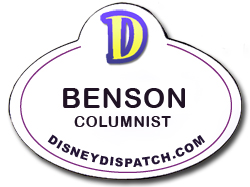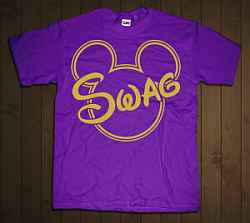FROM: It's All in a Nametag Published Thursdays
Walt Disney and Ma Bell
The relationship between Disney and Bell Systems stretches back decades. In 1967, Bell took over the sponsorship of an attraction at Disneyland, which they renamed Circlevision. They even pioneered an early version of Skype! Sort of. Let's dial in...
In 1876, a man named Alexander Graham Bell was a scientist and inventor working in the eastern part of the United States. His mother and wife were deaf, and he was seeking a way to use technology to devise a way to better help them communicate. After much experimentation, and failure, Bell and his assistant, Thomas Watson, created a device using a reed, some goat bladders, and a magnet that successfully reproduced sound waves across a wire. The first words spoken and received on the device, "Watson, come here! I want to see you!", have become part of American history.
Bell received a patent for his invention, and about a year later partnered with his father-in-law to establish a company to capitalize on the invention. They called it the Bell Telephone Company. Over the following decades, the company expanded its holdings, and purchased rival companies. Eventually, it spread nationwide and became known as the American Telephone and Telegraph Company, or AT&T; for short.
Most people simply referred to the whole company as The Bell System, or the colloquial name 'Ma Bell'.
Today I'd like to focus on the Bell System's involvement at Disneyland. Circarama, one of the opening day attractions at Disneyland, had been sponsored by the American Motors Corporation. In 1967, AMC ended its sponsorship. Bell System stepped up and became the new sponsor for the attraction. The name was changed from Circarama to Circlevision, and the show building was remodeled with a new facade and marquee.
Alexander Graham Bell in his later years.
The new "America the Beautiful" show building at Disneyland.
The 1967 opening ceremony for the new Tomorrowland, including the Bell Systems exhibits.
The Bell System Hostesses that worked the attraction at Disneyland.
Nametag worn by the Bell System Hostesses, around 1973 or so.
The Picturephone in use at Disneyland.
Circlevision at Disneyland
The film presented many historic locations and natural sites around America. Here is the script of the first few minutes of the film, to give you a taste of it:
She is a rich land. And a rare land. A fresh and fair land. A land so blessed in natural beauty, resources and people that she became the world's best hope. Come, take a look at her, Americans. Glimpse a nation's splendor, and be proud of your heritage. ("Give me your tired. Your poor, your huddled masses yearning to breathe free. The wretched refuse of your teeming shores. Send these, the homeless, tempest-tossed to me. I lift my lamp beside the golden door.")
Look at our portrait of America and for a few moments, see how a great nation was carved out of a wilderness. Let's begin our magic carpet ride in New York City, that great melting pot of people and cultures.
They came in their multitudes, bringing with them brains and muscles. Sinews and spirit. In pursuit of a dream. A dream that until now had never been. A dream that somehow, people could live together in justice and equality. A dream that democracy was the handwork of all. And that the glorious struggle could be won here. Where did this drive for the American dream begin? Not just in the great cities, but in towns and hamlets all over colonial America. The spirit of the early settlers is still all around us. Hundreds of years later.
Picturephone at Disneyland
Employees of the Bell System in Southern California acted as hostesses for the exhibits that were on display inside the show building. In 1967, a magazine for employees of the Bell System told all about it:
Feel like skiing the slopes at Sun Valley? Or flying low over the missile launching sites along Cape Kennedy? Or perhaps riding atop a speeding hook and ladder fire engine through the streets of downtown Los Angeles, at night?
At the new Bell System exhibit at Disneyland, more than 3,000 guests an hour are right in the middle of that action, and then some. The completely redesigned "America the Beautiful" pavilion has opened t the delight of Magic Kingdom visitors in Anaheim.
The filmed excursion of America takes place on a full-circle screen that highlights the 34,000 square foot pavilion at the entrance to a completely redone Tomorrowland, largest of several new Disneyland projects opening during 1967.
The new Tomorrowland brings the current amount spent on the tourist mecca since it opened in July, 1955, to nearly $100 million. In the Bell system pavilion, the audience is totally surrounded by the spectacular 18-foot vertical screens. Dozens of states are represented in the film that was produced by the Walt Disney Studios. You see Mount Rushmore, the White House, Mount Vernon, and Mount McKinley. California scenes include Yosemite National Park, San Francisco, Los Angeles, and Balboa Bay.
The pavilion also houses two other areas in addition to the theater. When you arrive inside, you are greeted by the show's theme song, "The Talk Song". One of the staff of 45 Southern Counties hostesses - representing all departments of the Bell Company - welcomes you, then tells the story of the evolution of the Bell System through a series of wall panels.
At the story's conclusion, a 32 foot long wall of doors topped by full length mirrors opens automatically into the theater. Guests pass through the doors into aisles separated by convenient handrails. Nine synchronized 35 millimeter projectors beam "America the Beautiful" on to the nine section circular screen that covers a diameter of 80 feet. After the 18 minute film, doors open again into the final area. Here are some interesting displays, where you can actually use advanced communications equipment. At two 'voice mirrors', guests can see and hear their own voices on a recording device.
At the Picturephone display, guests talk to and see the person to whom they are speaking. Every half hour, participants communicate directly by Picturephone with someone from the audiences at Montreal's EXPO 67, the Museum of Science and Industry in Chicago, or at the Franklin Institute in Philadelphia. There are even private Picturephone booths as well!
Other exhibits include a brightly lit Weather Station that lets you phone for the latest weather conditions in eight major U.S. cities. Six Family Booths enable an entire family to talk together over one line to any person, anywhere. And finally the Kiddie Phones, where children can talk to their favorite Disney characters and receive lessons on proper telephone operation and etiquette.
You might be wondering how the Picturephone worked. Well, it was very similar to the way video conferencing on a computer works today. If you are familiar with Skype, it's pretty much the same thing.
While the Picturephone service was futuristic and promising, it never really caught on. The service required a Picturephone unit to be on each end of the phone call. Each receiver cost several hundred dollars at the time, far more than most average guests could afford.
If you'd like an in-depth history of the Picturephone, I recommend you visit:
http://www.porticus.org/bell/telephones-picturephone.html
More: IT'S ALL IN A NAMETAG
Stuff Not to Skip
- Benson Myers's Blog
http://mousebadges.blogspot.com/2010/12/disney-store.html - Benson Myers's Nametag Museum
http://www.nametagmuseum.com







